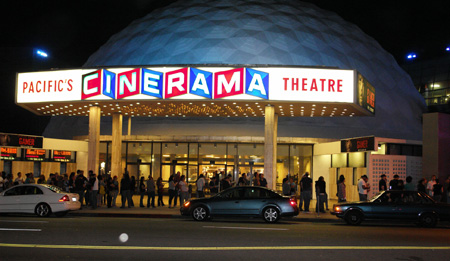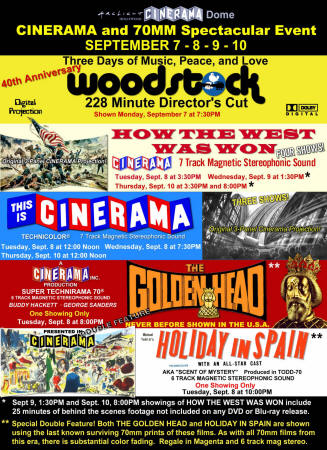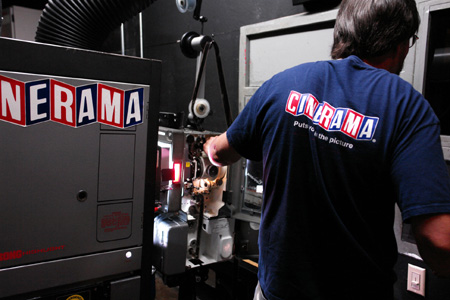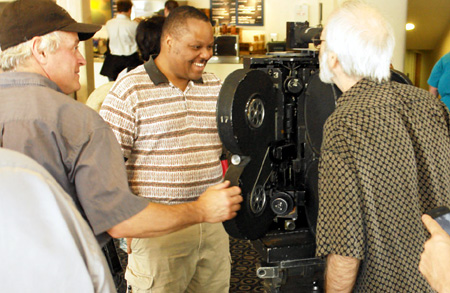The current state of Cinerama presentation in the U.S. |
Read more
at in70mm.com The 70mm Newsletter |
| Written by: Rick Mitchell, Hollywood, USA. Images by Tom March, Canada. | Date: 18.09.2009 |
 The
Cinerama Dome. Image by Tom March The
Cinerama Dome. Image by Tom MarchFollowing on the heels of the attention created by the successful revival of three panel Cinerama in the mid-Nineties by John Harvey, who moved his setup from his home in Dayton, OH to the New Neon Theater in that city, in 2002 Cinerama projectors were installed for the first time in the Cinerama Dome in Hollywood during an upgrade of that theater and reinstalled in the Cinerama Theater in Seattle, WA., with new prints struck of "This is Cinerama" and "How The West Was Won". The idea was that these films would be shown on some kind of regular basis at these theaters. Unfortunately, it did not work out that way. Because of technical problems related to setting up the presentation, there has been no Cinerama presentation in Seattle in several years. At the Dome, though the original plan was to show the films once a month at weekend matinees, this did not work out. There have been sporadic presentations over the last seven years, but not with the regularity of the Widescreen Weekend at the Pictureville Cinema in Bradford, England, the only other public venue in the world with a Cinerama setup. However there was a hopeful sign that this may be changed: for the first time Cinerama presentations at the Dome were held two years in a row at roughly the same time of the year. Last year it was a single Sunday matinee screening of HOW THE WEST WAS WON which drew a fairly full house despite the concurrence of one of L.A.'s many marathons that made access to the theater difficult. This year it was a Labor Day weekend of special historical screenings, starting with a digital presentation of the restored "Woodstock", which took up the four day weekend, with the three following weekdays devoted to the two Cinerama films plus a one night screening of surviving faded 70mm prints of "The Golden Head" and "Holiday in Spain". The first had never been publicly shown in the US, the second not in at least 45 years. |
More
in 70mm reading: 3-Strip at the Dome - and 70mm too! Who is Rick Mitchell? "How the West was Shown" News about "Cinerama Adventure" and Cinerama Dome "Zoot Suit": The last film in 70mm and Sensurround Plus Internet link: |
 Click
on flyer to see enlargement Click
on flyer to see enlargementFor a number of reasons, I saw the Cinerama films at matinees, but in a way, it was actually a valuable guide to the commercial viability of these screenings. Based on my 42 years of local moviegoing, I felt the turnout was average for a midweek matinee in a non summer/Christmas holiday week; I felt the turnout for "HTWWW" was slightly above average. (I felt the turnout for the 70mm films was average for a midweek night.) The turnout for the evening screenings of TIC and "HTWWW", which alternated on the next two nights, was naturally even better. I also found it interesting that more than 50% of those in attendance were in their Twenties and early Thirties. (A caveat here: there seems to be something going on here in LA that's not happening with revival/repertory theaters in the rest of the country, increased turnout for even obscure silent films by people in their Twenties and early Thirties and not just film students and film geeks.) And this despite the usual very limited advertising they've had in the past, mostly through the efforts of David Strohmaier, Rich Greenhalgh, Martin Hart of widescreenmuseum.com, and others spreading the word through e-mails and other techniques. (This year's screenings were also promoted by Cinecon, The American Cinematheque, and the Jules Verne Society, among others.) While the audience reaction to "TIC" was restrained; it has dated badly, the reaction to "HTWWW" was as enthusiastic as it has been at all the other Cinerama screenings I've attended over the last six years. The audience reacted favorably to the "folksy" material that a snootier "more sophisticated" audience would dismiss as corny and overheard comments from first timers implied that they were really impressed, though I didn't hear anyone say it was better than Imax, which I've heard in the past. |
|
 David
Strohmaier projecting Cinerama. Image by Tom March. David
Strohmaier projecting Cinerama. Image by Tom March.What this says to me is that not only Cinerama and film history fans but Pacific Theaters could benefit by establishing this as an annual week for such presentations, especially since as they have majority ownership of "HTWWW" and total ownership of "TIC", such presentations are mostly all profit for them. The turnout for the faded 70mm films, which was a real surprise, suggests that they could also include now faded prints of other relevant three panel or 70mm films on which it is too expensive to strike new ones or on which elements aren't known to exist. (Unfortunately there are apparently no longer any three panel prints of "WINDJAMMER" anywhere.) If people know that even just these two films are going to be shown on roughly these dates every year, a lot of people would plan to come from all over the country and possibly even other countries (I know of at least two people who came from Canada and England this year). From the theater's viewpoint, Labor Day weekend or the following week would be the best time to do this as now there usually are not any prominent new films released during these weeks. The negative aspect is that it is after the Summer holiday season and this may create attendance problems for some people especially from outside the Southern California area. Also, it is the start of the school year and this would affect mid-week screenings to which parents might like to bring children. It creates a similar problem with local film schools, including the LA Film School right across the street from the Dome, as there might not be time to get notice to students who might be interested. But if it were to happen on a regular annual basis, precedence suggests there would also be a significant number of people, both old and young, who would make a point to attend annually and likely bring in others. |
|
 The
Cinerama camera being admired in the Cinerama Dome foyer. Image by Tom
March. The
Cinerama camera being admired in the Cinerama Dome foyer. Image by Tom
March.The prints of "TIC" and "HTWWW" have held up very well. I noticed splices in individual panels but I doubt most non ex-projectionists would. I did experience my first breakdown with "TIC". The Vienna Boys Choir suddenly began slowing down, then stopped altogether, then the A, B, and C projectors snapped off in turn. After about three minutes everything restarted in sync. I guess they didn't expect this to happen and so didn't have the breakdown reel ready to go. But these prints are handled with the greatest care possible, adhering to standards set nearly 60 years ago. Here's hoping that these screenings do become a regular event. The author would like to thank Rich Greenhalgh, Thomas Hauerslev, Tom March, Paul Rayton, John Sittig, and especially David Strohmaier (all billed alphabetically as usual) for aid with this article. |
|
|
Go: back
- top - back issues
- news index Updated 22-01-25 |
|
